Hongsalmun
In architecture, a hongsalmun is a gate for entering a sacred place in Korea.[1][2] It is arranged by 2 round poles set vertically and 2 transverse bars.[1] It has no roof and door-gate and placed on the middle top gate there is a symbol of the trisula and the taegeuk image.[1] Hongsalmun is usually erected to indicate Korean Confucian sites, such as shrines, tombs, and academies such as hyanggyo and seowon.[1]
| Hongsalmun | |
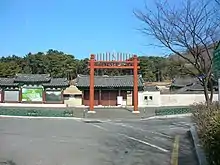 The hongsalmun at the lleung Royal Tomb(Joseon Dynasty royal tombs) | |
| Korean name | |
|---|---|
| Hangul | 홍살문 |
| Hanja | |
| Revised Romanization | Hongsalmun |
| McCune–Reischauer | Hongsalmun |
It literally means ‘gate with red arrows’, referring to the set of pointed spikes on its top. In the past, spikes in between columns did not exist.
Origin
Ancient Indian torana sacred gateway architecture has influenced gateway architecture across asia specially where Buddhism was transmitted from India; Chinese paifang gateways[3][4] Japanese torii gateways,[3][5] Korean Hongsalmun gateway,[6] and Sao Ching Cha in Thailand[5] have been derived from the Indian torana. The functions of all are similar, but they generally differ based on their respective architectural styles.[7][8]
- Asian sacred gateway styles originally derived from the Indian Torna
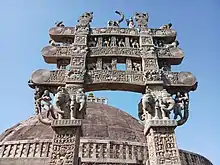 Indian Torana of Sanchi Stupa, a UNESCO World Heritage Site, dating to the period of the Mauryan Empire (3rd century BC), the torana itself dates to the Satavahana period, in the 1st century CE
Indian Torana of Sanchi Stupa, a UNESCO World Heritage Site, dating to the period of the Mauryan Empire (3rd century BC), the torana itself dates to the Satavahana period, in the 1st century CE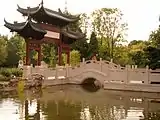 A Chinese Paifang (pailou)
A Chinese Paifang (pailou)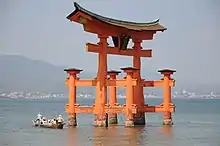 Japanese Torii at Itsukushima Shrine, a UNESCO World Heritage Site Japan, where the three daughters of Susano-o no Mikoto Ichikishimahime no mikoto, Tagorihime no mikoto, and Tagitsuhime no mikoto are worshipped.
Japanese Torii at Itsukushima Shrine, a UNESCO World Heritage Site Japan, where the three daughters of Susano-o no Mikoto Ichikishimahime no mikoto, Tagorihime no mikoto, and Tagitsuhime no mikoto are worshipped.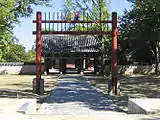 The hongsalmun at the shrine of the clan Yi of Jeonju
The hongsalmun at the shrine of the clan Yi of Jeonju_of_Illeung_Royal_Tomb_(%EC%9D%B8%EB%8A%A5).jpg.webp) The hongsalmun at the lleung Royal Tomb (Joseon Dynasty royal tombs)
The hongsalmun at the lleung Royal Tomb (Joseon Dynasty royal tombs)
See also
References
- An Illustrated Guide to Korean Culture - 233 traditional key words. Seoul: Hakgojae Publishing Co. 2002. pp. 186–87. ISBN 9788985846981.
- {{cite web| http://english.visitkorea.or.kr/enu/SI/SI_EN_3_6.jsp?cid=779495 |title=A Trip to Royal Tombs of the Joseon Dynasty |website=visitkorea |accessdate=June 12, 2010
- Albert Henry Longhurst (1992). The Story of the Stūpa. Asian Educational Services. p. 17. ISBN 978-81-206-0160-4.
- Joseph Needham, Science and Civilization in China, Vol 4 part 3, p137-138
- Scheid, Bernhard. "Religion in Japan". Torii (in German). University of Vienna. Retrieved 12 February 2010.
- A.H. Longhurst (1995). Story Of The Stupa. Asian Educational Services. pp. 17–. ISBN 978-81-206-0160-4.
- Ronald G. Knapp (2000). China's old dwellings. University of Hawaii Press. p. 85. ISBN 0-8248-2214-5.
- Simon Foster; Jen Lin-Liu; Sharon Owyang; Sherisse Pham; Beth Reiber; Lee Wing-sze (2010). Frommer's China. Frommers. p. 435. ISBN 0-470-52658-0.